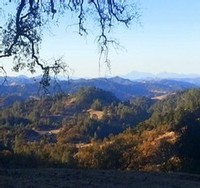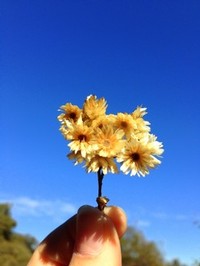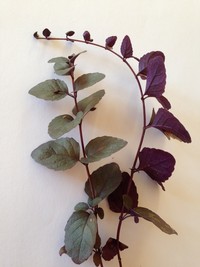On The Hunt for Botanicals
We had a rushed and exhausting harvest this year; it arrived early and was particularly relentless. In other years we've picked grapes for a few days, then had a few days "off," then picked some more--harvest usually strolls along like that for about 6 weeks. But this autumn, we picked day after day after day, followed by night after night in the winery. I hardly had time to feel sad about my youngest child's move to UC Santa Barbara. Thankfully she was very organized about gathering the essential goods and packing. We dropped her off on a stunningly warm and beautiful Sunday in late September.
 Angeline came home for the Thanksgiving holiday Tuesday night, and Wednesday afternoon we went for a long stroll on the west side of the ranch. We were searching for botanicals for the 2013 Flora Rose' label. We had a few plants in mind and set out to find some good samples to photograph. I had Laird's small Nikon and Angie had her trusty iphone. Last year's winning picture of Bay Laurel for our Rose' label was taken with her phone--technology is pretty amazing. We were hoping to get pictures of plants in the field and to collect some for more photographing against a white background at home.
Angeline came home for the Thanksgiving holiday Tuesday night, and Wednesday afternoon we went for a long stroll on the west side of the ranch. We were searching for botanicals for the 2013 Flora Rose' label. We had a few plants in mind and set out to find some good samples to photograph. I had Laird's small Nikon and Angie had her trusty iphone. Last year's winning picture of Bay Laurel for our Rose' label was taken with her phone--technology is pretty amazing. We were hoping to get pictures of plants in the field and to collect some for more photographing against a white background at home.
So about wine labels: every label must be approved by the federal government before it can be printed and applied to a bottle of wine. Naturally, organizing our work around the approval of the sluggish Bureau of Alcohol and Tobacco Tax and Trade (TTB) can be frustrating. Usually we set our two bottling dates (early April, late August) months in advance, and work backwards from there to get the label ready. There is often a backlog at the Bureau, anywhere from several weeks to several months, making label approval one more thing our winemaker Shannon has to worry about. For most of our varietals, the label changes are very minor: just updating the year on the front label, the percentage of alcohol, and the percentage breakdown of any blends. But with the Flora Rose' we change the picture and the description on the back label each vintage, and are almost always surprised that it is once again that time of year--a scramble to select a botanical for the label.
Throughout the year I try to take pictures of wildflowers so that we have plenty to choose from; we have a pretty good selection on the computer. But this year we had other plans. There aren't many flowering plants in the winter, but we knew of a few that we particularly love. Pearly Everlasting (anaphalis margaritacea) blooms in summer and bears many clusters of small white blossoms. They dry out in the fall and are a sturdy, pretty, cream-colored dry flower (hence the everlasting). They also have a distinctive butterscotchy, brown sugar fragrance when you crush the flowers in your fingers. It's a food plant for butterflies and was used by Native Americans as a salve for burns. Angeline and I found several specimens on the rocky, sagebrush trail to our springs. We experimented with photographing the plant as it stands, and holding it up against the blue sky.
We were also looking for Yerba Buena (Clinopoduim douglasii), a native mint plant that grows under oaks and alongside shady creeks, low and runner-like in the rich soil. Yerba Buena is the common name, which means good herb in Spanish. The first we came upon were dried and gray; the drought has definitely affected the plant life on the ranch this year. But once we got to our springs, where the sunlight barely filters in and lush ferns and madrone grow, we found some beautiful samples. The leaves are almost heart shaped, and a vivid purple on the underside. The plant has a strong minty scent and was used medicinally by natives. Laird and Nathan had been cutting wood earlier in the week, beneath an oak, and Laird had waxed poetic about the cool sunny day, with the scent of crushed mint wafting up from beneath their boots. That's what gave me the idea to hunt this plant down and possibly feature it on our label.
While at the springs we checked the level of Lake Rufus, which was quite low. This lake (a small pond, really) was named after our now departed chocolate lab, who spend many summer up there while Laird and the boys developed our water system. Rufus was always game for a wet fetch or swim. The water level was way down, but even so Arrow, our tireless fetcher, could not be persuaded to get his pretty white feet wet. There were dozens of fat goldfish swimming around, the survivors of a bucket of cheap goldfish that Angie and her cousin doled out in every trough and pond one long ago summer. They are surprisingly hearty.

Field of Dreams
Late in the afternoon I decided to walk to our little rental house to check on the garden. I pulled my cowboy boots on (baby snake season!) called Silver the dog and we set off on our 2 mile jaunt. The clover and vetch on the way down to the lake was thick and buzzing with bees. We came right upon a huge ground squirrel mound with the squirrel sitting right at the “door”. Silver couldn’t quite believe his luck; in his second of hesitation the squirrel dove into his hole. Silver went after him, squirrel squeaking, Silver digging and tossing aside clumps of sod with his mouth. I kept on down the hill and finally had to call him off the hunt.
Right in the middle of the road I found two halves of a fragile, palest blue bird egg. I put a half on each of my thumbs, so I wouldn’t crush them while I walked.

As I walked back home up the big, big hill, huffing and puffing a little, the rams and young male lambs in the pasture below the house greeted me. On the very last push, up the bank to the patio, I saw my one and only snake. A baby king snake about 6 inches long, starkly black with white bands, the width of a pencil. He squiggled up the hill as my shadow crossed his path.
Readings and Musings
A rich aspect of agricultural life is seasonality and the change of pace that comes with it. Wintertime brings shorter days, longer nights and soggy weeks. After 300+ days a year of sunny and often hot weather in Paso Robles, capped by the long days of the wine harvest, we gladly huddle indoors on occasion and enjoy an oakwood fire. There is more time for reading and indoor work on the business side of ranching and winemaking, as well as time to reflect.
I began my winter reading with Richard Rhodes' Arsenals of Folly, which recounts the history, proliferation and attempts to limit nuclear arms. It is a chilling ride that brings the Cold War to life and reminds us of the fundamental risks of modern life and technology. While reading that book in the deep of a November night (3:07 AM, actually), I was startled to see what I thought was a bright and persistent shooting star out my bedroom window. I went out on our south-facing balcony to watch it arc across the sky when I realized I was watching a missile launch, the ghostly trail of which lingered in the night sky as if left the atmosphere far out over the Pacific. This apparition had been a Vandenberg Air Force Base test launch of a Minuteman intercontinental ballistic missile (ICBM), whose designed purpose is to carry a nuclear weapon to the far side of globe. I was profoundly moved at the eerie coincidence. I have not been able to stop thinking about it for very long since.
 I was so impressed by Richard Rhodes writing that I sought out another of his books: John James Audobon: The Making of an American. This book provided a rich plunge into the world of early 1800s frontier America. It is, for me, a gripping tale of the great naturalist, artist and publisher spanning decades of misfortune, persistence and eventual triumph. Audobon's _Birds of America_ was the finest ornithological work of its time and his paintings set new standards for natural realism. His scenes have a wild, strange, sometimes violent quality that Rhodes summed up as "the concentrated essence of the wilderness". What really struck me in the book was the dramatic environmental changes already taking place in North America. Audobon observed that through deforestation and overharvesting of wildlife in 1830, "Nature herself is perishing".
I was so impressed by Richard Rhodes writing that I sought out another of his books: John James Audobon: The Making of an American. This book provided a rich plunge into the world of early 1800s frontier America. It is, for me, a gripping tale of the great naturalist, artist and publisher spanning decades of misfortune, persistence and eventual triumph. Audobon's _Birds of America_ was the finest ornithological work of its time and his paintings set new standards for natural realism. His scenes have a wild, strange, sometimes violent quality that Rhodes summed up as "the concentrated essence of the wilderness". What really struck me in the book was the dramatic environmental changes already taking place in North America. Audobon observed that through deforestation and overharvesting of wildlife in 1830, "Nature herself is perishing".
Moving on in my literary journey, I read Wendell Berry's The Gift of Good Land. Nathan, our ranch manager, had recommended it to me and was so moved by the book that he read passages aloud to us. The Gift is a collection of essays on sustainable farming published in 1981 that is still strikingly relevant. Berry's prose is so thoughtful and beautiful that I found myself marking page after page with dog eared corners.
On the work of family farmers Berry comments: "The work of factory workers is ruled by the factory. Whereas the work of housewives, small craftsmen and small farmers is ruled by their own morality, skill and intelligence" and "society...may lose...efficiency and economy of scale. But it begins to gain...independence, pride, respect....love, reverence."
On cattle feedlots: "within the boundaries of the feeding operation itself a certain factory-like order and efficiency can be achieved. But [it] produces biological disorder, for we know that health problems and dependence on drugs will be greater among cattle so confined than among cattle on pasture. And beyond those boundaries, the problems multiply."
 On life: "the world, the weather, and the life cycle have caused me no end of trouble, and yet I look forward to putting another forty or so years with them because they have also given me no end of pleasure and instruction. They interest me. I want to see them thrive on their own terms."
On life: "the world, the weather, and the life cycle have caused me no end of trouble, and yet I look forward to putting another forty or so years with them because they have also given me no end of pleasure and instruction. They interest me. I want to see them thrive on their own terms."
On farming: "Agriculture depends on nature and is contained in nature; if you want to understand agriculture, therefore, you must understand what preceded it."
So what does all of this reading and reflection have to do with growing (and enjoying) good food and fine wine? Everything.
Keep up to date on the latest wine releases, events, and promotions and get 10% off your next order.

